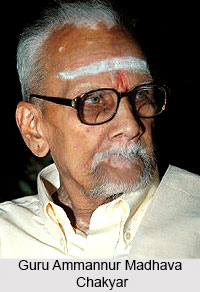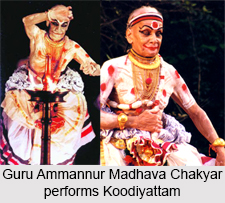 Padma Bhushan Guru Ammannur Madhav Chakyar was a master of Koodiyattam, regarded as the one of the greatest performers of the ancient Sanskrit theatre art form. He was one of the all time greats, who along with Painkulam Damodara Chakyar and Mani Madhava Chakyar, together referred to as the trinity of Koodiyattam, was instrumental in taking the theatre form outside the precincts of the temple theatres of Kerala and popularising it across the country and beyond. In the year 2001, it was Guru Ammannur Madhava Chakyar who was selected to receive the UNESCO citation that proclaimed Kutiyattam as a "Masterpiece of the Oral and Intangible Heritage of Humanity."
Padma Bhushan Guru Ammannur Madhav Chakyar was a master of Koodiyattam, regarded as the one of the greatest performers of the ancient Sanskrit theatre art form. He was one of the all time greats, who along with Painkulam Damodara Chakyar and Mani Madhava Chakyar, together referred to as the trinity of Koodiyattam, was instrumental in taking the theatre form outside the precincts of the temple theatres of Kerala and popularising it across the country and beyond. In the year 2001, it was Guru Ammannur Madhava Chakyar who was selected to receive the UNESCO citation that proclaimed Kutiyattam as a "Masterpiece of the Oral and Intangible Heritage of Humanity."
Early Life and Family of Ammannur Madhava Chakyar
Guru Ammannur Madhava Chakyar was born on May 13, 1917, into the Ammannnur Chakyar family, to Sreedevi Illodamma and Vellarapilli Madassi Manakkal Parameswaran Nambutiri, at Irinjalakuda in the Thrissur district of Kerala. His family was a hereditary Koodiyattam family and thus, he was initiated into the art form at the age of 7.
Training and First Performances of Ammannur Madhava Chakyar
Ammannur Madhava Chakyar trained rigorously in Koodiyattam under his two uncles Ammannur Chachu Chakyar, Ammannur Valiya Madhava Chakyar and Kidangur Rama Chakyar. His teacher in Natyashastra and Abhinaya was Bhagavatar Kunjunni Thamburan of the acting laboratory at the Kodungallor Royal family. He was taught Sanskrit by Kochikkavu Thampuratty and Manthitta Namboothiri.
His "arangetram" (debut performance) was at the age of 11, at the Thirumandhamkunnu Bhagavathi temple in the Malapuram district of Kerala, performing the role of Sutradhara in Bhasa"s `Balacharitam`. At the age of 14, he gave his first performance at the Koothambalam (temple theatre house) of Vadakkunnathan Temple in Trichur, performing as Rama in `Balivadham`. At the age of 16, he had his debut in Prabandha Koothu, with the ritual Kuduma Vakkal at the Puthiya Thrikkovil, located in Chendamangalam in Thrissur, Kerala.
Later Performances of Ammannur Madhava Chakyar
Associated as a performer with the Kutalmanikkam temple in his hometown, Ammannur Madhava Chakyar perfected all the major Kutiyattam characters. He has given many stellar performances and his histrionic abilities have left onlookers spellbound on many occasions. The maestro"s repertory of memorable roles include the following characters, followed by the plays in which they appear.
•Bali in "Balivadham"
•Ravana in "Thoranayudham", "Asokavanikankam", "Hanumaddutam" and "Jatayuvadham"
•Suta and Jatayu in "Jatayuvadham"
•Surpanakha in "Surpanakhangam"
•Hanuman in "Thoranayudham" and "Ankuliyankam"
•Dhananjayan in "Subhadra Dhananjayam"
•Bhima and Vidyadhara in "Kalyanasaugandhikam"
•Kapali in "Mattavilasam", and
•Vidushaka in "Subhadra Dhananjayam", "Tapatisamvaranam", "Naganandam" and all the important Prabandhas in Koothu
The complete text of `Asokavanikankam` performed at Irinjalakuda, 25 years ago, was fully documented and is now a prized treasure in the archives of Sangeet Natak Akademi, New Delhi.
Ammanur Madhava Chakyar was also instrumental in surpassing traditions, which saw the art form of Koodiyattam coming out of the confines of the temple walls, extending and being popularised across the nation. In the 1980s, he became one of the first Koodiyattam performers to present his art to international audience, visiting France in 1982, 1986 and 2001, England in 1982 and 1987, Switzerland and The Netherlands in 1987 and Japan in 1988. He instantly drew the admiration of the local audiences there. The great maestro also became part of another milestone, not only for Koodiyattam, but also for all other Indian art forms in the year 2001, in Paris. A Koodiyattam performance by Ammanur Madhava Chakyar was organised by the UNESCO, in honour of its selecting the ancient theatrical art form as a `Masterpiece of the Oral and Intangible Heritage of Humanity`.
Ammannur Madhava Chakyar also prepared "attaprakarams", which are acting manuals written for performance of a few plays and acts that the genre had lost. These include `Attaprakaram - Kramadeepika`, for three important acts of `Acharyachoodamani,` namely "Parnshalankam", "Mayasitankam" and "Ezhamankam"; "Abhisheka Natakam" for plays "Hanumaddutam" and "Samudrataranam" and "Nangiar Koothu" for "Sree Krishna Charitam". After teaching at Kerala Kalamandalam and Margi in Thiruvananthapuram, he established the Ammannur Chachu Chakyar Smaraka Gurukulam, a training centre for Kutiyattam at Irinjalakuda in the Thrissur District, in his uncle`s memory. He also became the central instructor for the Sangeet Natak Akademi`s project to preserve Kutiyattam and was the Chief Resource person life long at Natanakairali - Research and Performing Centre for Traditional Arts in Irinjalakuda. Some of his disciples who are well-established performing artists include Moozhikulam Kochukuttan Chakyar, Ammannur Kuttam Chakyar, G. Venu, Usha Nangiar, Margi Madhu, Ammannur Rajaneesh Chakyar amongst others.
Awards and Recognitions received by Ammannur Madhava Chakyar
The master artist Ammannur Madhava Chakyar was bestowed the following awards and honours:
•Nrutha Natya Puraskaram from Government of Kerala, 2007
•Padma Bhushan from Government of India, 2002
•P. S. John Endowment Award from Ernakulam Press Club, 2002
•Degree of Doctor of Letters from Kannur University, 2002
•Citation of UNESCO recognising Kutiyattam in 2001
•`Pattum Valayum` from Keli and Prithvi Theatre, Mumbai in 1998
•Peelithirumudi Award from Guruvayur Temple, 1997
•Fellowship from Sangeet Natak Akademi in 1996
•`Veera Sringhala` from The International Centre for Kutiyattam, Thripunithura in 1994
•`Sree Guruvayoorappan Samman` from Guruvayur Temple, 1992
•`Kalidas Samman` from Government of Madhya Pradesh in 1992
•Fellowship from Kerala Kalamandalam in 1988
•`Natya Kala Nidhi` title from Cochin Devaswam Board in 1987
•Padma Shri from Government of India, 1982
•Sangeet Natak Akademi Award in 1979
Ammannur Madhava Chakyar suffered from many serious health problems in his last years. On May 13, 2007, he celebrated his 90th birthday at his home at Irinjalakuda. Later his health deteriorated and he passed away in the early hours of July 2, 2008, aged 91.
Related Articles:
Sanskrit Language
Forms of Indian Theatre
Kerala
Folk Theatre of Kerala
Sanskrit Theatre
Classical Indian Dance Drama
Koothu
Abhinaya, Indian Art Form
Natyashastra
Bharata Muni
Indian Classical Dance
Koodiyattam, Folk Theatre of Kerala




